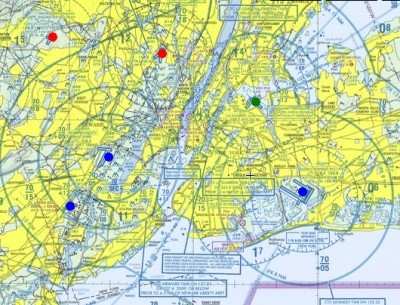Tue, May 20, 2014
New Air Traffic Control Facility In The Design Phase
Several new FAA initiatives will help reduce delays and save time and money for passengers and airlines in the New York area, the busiest and most complex airspace in the country. The FAA is modifying the approach to airspace redesign in New York after completing the first two phases, and is beginning the design process for a new state-of-the-art air traffic facility.

The new air traffic facility on Long Island will replace the existing Terminal Radar Approach Control, or TRACON facility, currently located in Westbury, NY. The new facility may be at a location with the capability to expand to manage operations from other facilities in the area.
The FAA has completed the first two stages of a New York-New-Jersey-Philadelphia Airspace Redesign which have brought tangible benefits to airlines operating in the New York and Philadelphia metropolitan areas. New procedures and routings now de-conflict departures, reduce delays, and allow aircraft to reach overhead jet routes more efficiently.
Over the next year, the FAA will begin an effort to further reduce delays in the airspace over New York through a collaborative initiative, based on the successful Metroplex approach that we are using in other major markets across the country. A Metroplex is a metropolitan area where multiple commercial and general aviation airports operate within the same airspace. Congestion, activity at multiple airports in close geographical proximity, and other limiting factors all can reduce efficiency in busy Metroplex areas.

The FAA is collaborating with industry to ease the bottlenecks by using Precision Based Navigation (PBN) procedures to deliver more efficient operations and benefits to these areas. This effort is designed to optimize complex airspace with procedures that improve the flow of air traffic into and out of the airports in each area. Before implementing any airspace changes, the FAA ensures that all the required environmental analysis is completed. The FAA has already implemented airspace improvements in the Washington DC area, and additional work is underway for other congested metropolitan areas like north Texas and Seattle.
The FAA is committed to continuing efficiency and safety improvements for passengers, airlines, and other airspace users.
More News
Aviation Governance Secured...At Least For a While The National Business Aviation Association similarly applauded the passage of the FAA's recent reauthorization, contentedly recou>[...]
Emphasis On Growing The Future of Aviation Through Concentration on 'AFFORDABLE FLYERS' It's been a number of years since the Latest Edition of Jim Campbell's HUGE SportPlane Resou>[...]
Amazilia Aerospace GmbH, Develops Digital Flight Control, Flight Guidance And Vehicle Management Systems Textron eAviation has acquired substantially all the assets of Amazilia Aer>[...]
Honeywell's Primus Brings New Tools and Niceties for Hawker Operators Hawker 4000 business jet operators have a new installation on the table, now that the FAA has granted an STC f>[...]
Company Celebrates Niche-but-Important Advancement in Industry Standards Echodyne has announced full integration of its proprietary 'EchoFlight' radar into the e American Aerospace>[...]
 Bolen Gives Congress a Rare Thumbs-Up
Bolen Gives Congress a Rare Thumbs-Up The SportPlane Resource Guide RETURNS!!!!
The SportPlane Resource Guide RETURNS!!!! Buying Sprees Continue: Textron eAviation Takes On Amazilia Aerospace
Buying Sprees Continue: Textron eAviation Takes On Amazilia Aerospace Hawker 4000 Bizjets Gain Nav System, Data Link STC
Hawker 4000 Bizjets Gain Nav System, Data Link STC Echodyne Gets BVLOS Waiver for AiRanger Aircraft
Echodyne Gets BVLOS Waiver for AiRanger Aircraft




